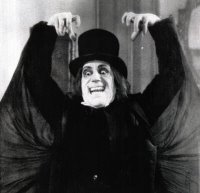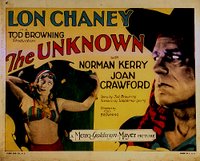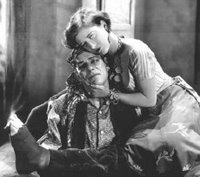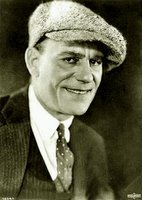THE ARMLESS MAN
On Sunday October 1, Turner Classic Movies is airing two Lon Chaney films, LONDON AFTER MIDNIGHT and THE UNKNOWN.
Chaney was one of America’s first movie stars, who ruled the horror genre in its silent heyday. Known as the “Man of a Thousand Faces,” his most famous roles were the title characters in THE PHANTOM OF THE OPERA and THE HUNCHBACK OF NOTRE DAME. The protean actor created his own make-up designs, many of which included painful and even torturous devices to create his illusions.
LONDON AFTER MIDNIGHT is legendary to horror buffs because it has long been considered a “lost film.” The version airing Sunday evening has been restored (recreated from production stills).
 Theatrical films produced prior to 1951 were made on nitrate stock – a highly volatile substance prone to fire and decay. Almost 90% of all silent films have been lost. Occasionally, a rare print turns up somewhere - like in an attic (usually far from Hollywood). In the case of Carl Dreyer’s THE PASSION OF JOAN OF ARC, a print was found in the closet of a mental institution.
Theatrical films produced prior to 1951 were made on nitrate stock – a highly volatile substance prone to fire and decay. Almost 90% of all silent films have been lost. Occasionally, a rare print turns up somewhere - like in an attic (usually far from Hollywood). In the case of Carl Dreyer’s THE PASSION OF JOAN OF ARC, a print was found in the closet of a mental institution.
Sunday night’s screening of LONDON AFTER MIDNIGHT (which was never purported to be a particularly good movie) will be the first time some fans have ever seen even a likeness of the film – 79 years after its initial release. Tod Browning - a collaborator of Chaney’s – directed the movie.
The double feature opens with THE UNKNOWN.
It’s a movie to which I often refer when discussing the idea of “brainstorming” and the concept of "unity."
 The notion of “unity” often eludes writers, and their stories feel oddly disconnected from themselves.
The notion of “unity” often eludes writers, and their stories feel oddly disconnected from themselves.
I’ll often hear a pitch where the second part doesn’t flow organically from the first.
As an example, here is logline and my response from an earlier blog entry:
LOGLINE: After intercepting a ransom demand, a barber--masquerading as a private eye, reluctantly joins forces with an angst ridden teen in attempt to rescue the daughter of a stuffy millionaire at a fraction of the cost.
RESPONSE: Although the idea of “intercepting a ransom demand” has some sort of potential, there is little “cause and effect” within this concept. Everything feels slapped together. It isn’t clear why a barber is involved in any of this or why he poses as a private eye. Then an angst ridden teen enters the mix and has no obvious relation to the barber or the kidnapping.This might make a tiny bit more sense, for instance, if the angst ridden teen were the shampoo girl, and the kidnap victim the daughter of “Fantastic Sam.” At least there would be some connective tissue to the various parts instead of the disparate nature of the logline as presented.
This concept lacks a sense of “unity.”
When trying to define “unity” to students, I often refer to "THE ARMLESS MAN."
This is a reference to the character Chaney plays in THE UNKNOWN.
THE UNKNOWN (1927) is one of eleven films that star Chaney and macabre director Browning made together from 1919-1928.
In this film, Chaney plays an armless circus performer who falls in love with a beautiful trapeze artist (played by Joan Crawford).

In this excerpt from “Chronicles of Terror: Silent Screams,” author Steven Haberman writes about how Tod Browning and Lon Chaney would brainstorm story ideas.
“Browning stated that when he was working on a story for a Chaney film, the character would come first, and the plot would grow from that character. “When we’re getting ready to discuss a new story,” Browning told the press, Chaney would “amble into my office and say, ‘Well, what’s it going to be boss?’ I’ll say, ‘This time a leg comes off, or an arm, or a nose– whatever it may be.’ In the case of THE UNKNOWN, Browning said that he merely came up with the idea of an armless man and then created startling dilemmas for a person with such a problem. The character of the beautiful girl repulsed by men’s hands was a brilliant inspiration as a romantic goal for Browning’s armless man. As an added turn of the screw, Browning then decided that the man secretly would have arms. Why would he want to hide his arms? Because he is a criminal and could be identified by his peculiar hands. And what would this character do when faced with such a condition for the love of the woman he desires? He would have his arms amputated, of course. This type of insane logic seems to follow naturally in the story, so relentless is its construction around one single idea. Every subsequent plot twist puts another pressure on the man with no arms. What is the worst thing that could happen to him upon having his arms removed for the girls he loves? She overcomes her fear of arms and falls for the strongman, of course.”
Clearly, this is an example of "unity" taken to an extreme. But it makes a lucid illustration of how to brainstorm an idea with conflict, creating a "cause and effect" narrative that feels organic, connected and, of course, dramatic.
When brainstorming - remember THE ARMLESS MAN.
The great Lon Chaney died August 26, 1930 but lives again for a few hours on Sunday night.

Send questions and comments to theinsidepitch@sbcglobal.net


0 Comments:
Post a Comment
<< Home